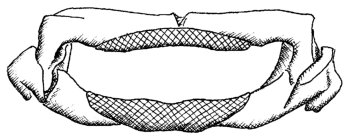Compared with the Rajiformes, dasyatids have more broadly expanded (generally rhombic-shaped)
discs, long (whip-like) tails, no dorsal or caudal fins, and reduced or absent pelvic fins. The stingrays
bear thorns, but are better characterized by their caudal stinging spine. The teeth are small and
arranged in numerous files. Females have a crushing, and males often a clutching, dentition.
The dasyatids are coastal rays, frequenting shallow waters (including estuaries and freshwater rivers)
and preferring sub-tropical and tropical temperatures.
Bigelow & Schroeder inventoried these rays in 1953, when they listed six species for the western
North Atlantic, but only four would be likely candidates for Lee Creek waters. The species include:
Dasyatis americana HILDEBRAND &
SCHROEDER, 1928,
D. centroura (MITCHILL), 1815,
D. sabina (LESUER), 1824,
and D. sayi (LESUER), 1817.
Dasyatis americana
HILDEBRAND
& SCHROEDER, 1926
Southern stingray
This is a medium-sized (to 5' in width) ray of subtropical and tropical coastal waters. A
widespread species (having been reported from New Jersey to Rio de Janeiro and
throughout the Caribbean and Gulf of Mexico), it prefers open areas of sand and mud bottoms,
feeding on clams, worms, shrimp and small fish. It bears thorns on the back and tail.
The crushing female dentition (figure 4) is made up of low-crowned teeth (figure 3). The
illustrated specimen, USNM #232,720 has 38 upper and 46 lower files.
The upper teeth are about 1.8 mm in width in the anterior positions, enlarge to 2.8 mm laterally,
then drop back to 2.0 mm distally. The lower files generally graduate mesio-distally from
2.2 to 1.2 mm, although files three through seven are slightly enlarged.
The clutching male dentition is made up mostly of high-cusped teeth (figure 2). The specimen
used for the illustration, USNM #232,720 had 43 upper and 47 lower files.
The upper teeth are all high cusped and most are about 2.0 mm in width, although the last
few distal files are less wide. The lower files generally graduate mesio-distally from 2.0 to 1.5 mm,
and after file ten, the cusps start diminishing in size.

Fig. 2 Dasyatis americana
USNM #232,720, female dentition 12.2 cm in width |

D. americana lower files, USNM #232,720, Labial at top
Fig. 3 (left) Male. 2nd LH thru 5th RH file;
Illustrated width = 9.0 mm.
Fig. 4 (right) Female. 4th LH thru 2nd RH file;
Illustrated width = 8.0 mm. |
For a good outside link on D. sabina try
The Atlantic Stingray